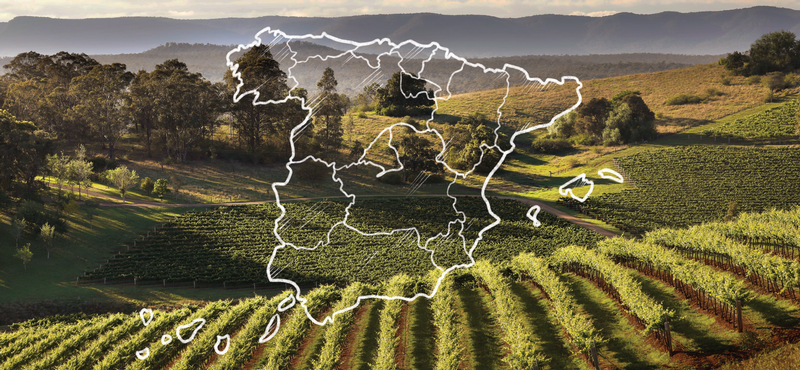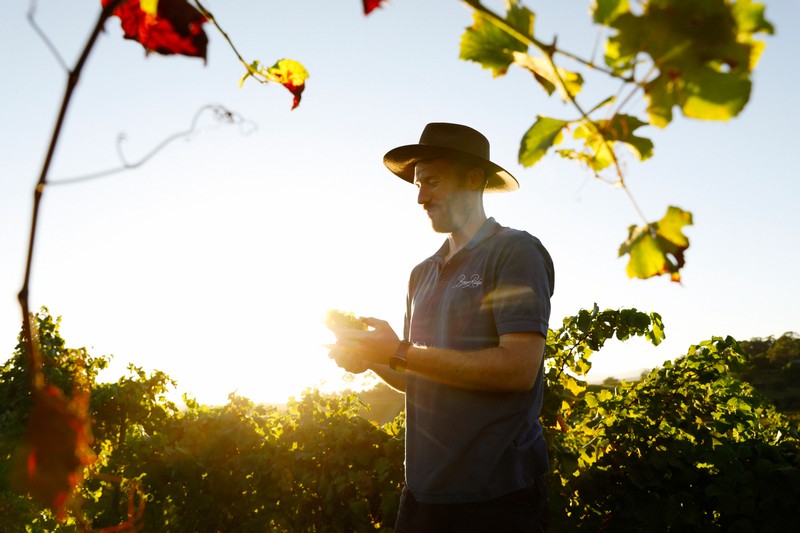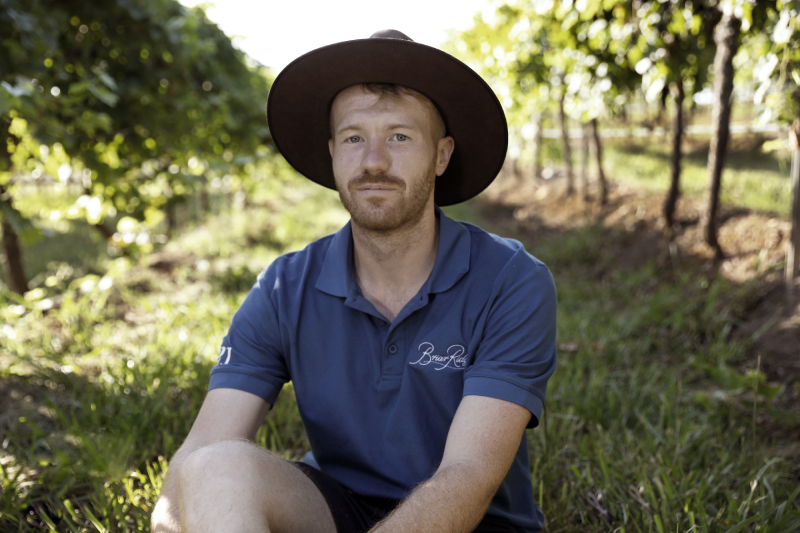Celebrating Spain Day with an exploration of our spanish varietals

Earlier this month marked the National Day of Spain – an annual holiday for Spaniards to celebrate their homeland, and an opportunity for people around the world to pay homage to what they love most about this special country. And for us, that’s easy – their wine, of course!
Not only do we enjoy drinking delicious bottles produced in Spain, we’ve also adopted a few of their famous grape varietals into our own fold here at Briar Ridge. A huge part of our philosophy is growing and developing wines less commonly found here in Australia, and three of our favourites are from this part of the world. So let’s explore what they’re all about, and what makes the Hunter Valley an excellent place for them to flourish.
Spain now has more land under vine than any other country and, while it may not have the same lauded reputation, it’s the second-largest producer of wine in the world, behind Italy but ahead of France. It's home to over four hundred native grape varieties, though a large percentage of production occurs with just twenty grapes. The three that we produce – tempranillo, verdelho (a Portuguese grape, which we're including as Spanish on account of the Iberian Peninsula), and albariño – are amongst Spain’s most notable wine styles, alongside others including cava, a sparkling wine made in the traditional method; jerez, known around the world as sherry; verdejo; and monastrell (called mataro in Australia).
Due to Spain’s warm and sunny Mediterranean climate, native Spanish grapes have evolved to thrive in high temperatures, while also being able to stand up to the coastal elements that come part and parcel with a wine region mainly located along a peninsula. Australia shares many similarities with Spain's climate, and the Hunter Valley, with its distinctive oceanic influences, has proven to be a boon for growing Spanish grapes. Though historically the Hunter has been one of Australia’s hottest and wettest wine regions, recent effects of climate change have meant less reliable rainfall, making it even more important to focus on grapes that are known to withstand heat stress.
With climate change projections across the country showing further increases in temperature and reduction in annual rainfall within the next ten years, we envision an increase in cultivation of grape varietals from Spain and other mediterranean parts of the world. It seems not only will our exploration of these grapes fulfil our desire to offer our customers a wide range of wine styles, they are also going to become critical to our survival and that of the Australian wine industry at large. Good thing they’re so delicious, then!
Tempranillo
Tempranillo is arguably Spain’s most famous grape variety, and one of the world’s fastest-expanding wine styles. It’s very easy to fall in love with – tempranillo grapes produce a deliciously easy-drinking red with vibrant colour and plush fruit flavours. These wines also tend to have medium acid and higher tannins, making them suited to accompanying a wide range of foods. Our tempranillo tends to be full-bodied and flavoursome, with notes of dark red fruits, spice and honey soy and a long and tasty finish. We also often use our tempranillo grapes in a shiraz tempranillo blend, to create a traditional Spanish ‘joven’ style of wine, meaning it's designed to be drunk young, without the need for cellaring.
Albariño
Albariño is considered Spain’s most fashionable white wine, with its crisp fruit flavours and light minerality. Its native home is in the Rias Baixas wine region of Galicia, which is on the north-west coast of the country, close to Portugal. This area is slightly cooler than other parts of Spain, and is classified as a warm maritime climate, just like the Hunter Valley. High-quality albariño grapes produce wines with ripe fruit, low alcohol and high acid, similar to Hunter semillions. This varietal actually has quite the dramatic past in Australia: in 2009, it was discovered via DNA testing that the albariño winemakers were growing and selling was actually not albarino at all, it was savagnin – a grape from Jura in France. This was due to a mix-up when Spanish authorities supplied the propagating material to the CSIRO in 1989, and caused a lot of headaches!
Thankfully, our vines were procured after this revelation, so we know our albariño is the real deal, and is one of only two currently produced in the Hunter. Our first vintage was in 2018, after we did some restructuring of the vineyard to bring in grapes we thought would be better suited to our climate. We were pleasantly surprised at the fruit intensity of the grapes straight away – even in the first crop harvested off very young vines – and it has continued to impress in the years since. This exciting wine is beautifully fragranced, packed with lemon zest and tropical notes, and balanced with texture and a richness from yeast lees. It makes a great match with seafood dishes, as well as mildly spicy foods like chicken satay or nasi goreng.
Verdelho
The Verdelho grape isn’t technically native to Spain, but it is to Portugal — which is a very close neighbour and the other country that comprises the Iberian Peninsula — so we figured we could get away with it. It originated in the Portuguese island of Madeira in the Atlantic Ocean, off the coast of Morocco, where it is made into a fortified wine called Madeira.
This is one alternative grape varietal that is certainly not new to our shores – in fact, it was first imported into Australia in 1825 by the Australian Agricultural Company, and its presence in the Hunter Valley dates back to the early 1900s. For years it was also used here in the production of fortified wines, but in recent times it has developed into a more balanced style with a similar weight to an unoaked chardonnay.
Grapes for our verdelho grow plump and juicy right beside our famed natural Hunter Valley dam. Fresh, tropical and lively, we consider this wine the perfect all rounder – sure to please many palates with its notes of red apple, guava and passionfruit. It’s a perfectly balanced and refined take on the now popular Portuguese varietal, and a fantastic entry point into exploring more alternative wine styles. Salud!
Back to the future with Briar Ridge winemaker Alex Beckett

If you ask Alex – and naturally, we did – there's plenty to look forward to when it comes to the future of both Briar Ridge's wines and his own career. It's been a big five years for the local winemaker, but if everything goes to plan, the next five are shaping up to be bigger.
"We're currently fine-tuning and really honing our single-vineyard wines," he says. "Right now, they are considered benchmarks for the region, but I would like them to be benchmarks of their grape varieties in the country, so there's a real pursuit of excellence here."
"We're also continuing to expand our portfolio of alternative and emerging varieties. We’ve been growing fiano and albariño for four or so years now, and those wines are getting better and better. We did our first vintage of barbera in 2020, we have a malbec coming up and we’re also working on cabernet franc and a couple of other miscellaneous Bordeaux grapes that don’t always get the time to shine on their own. Developing and playing around with those over time, seeing what works and what doesn’t, is going to be really fun and interesting.”
Our ever-expanding range of wines certainly keeps Alex's hands full, and though he acknowledges it would probably make his life a bit easier if we limited ourselves, he thinks the willingness to explore is a really important part of Briar Ridge’s story.
“While we have this wonderful heritage and a stunning site that can make some of the best grapes in the Hunter, we also have the capacity to make wine a bit more fun. We make wines that aren’t particularly common, even if we know that they might be challenging for consumers at first. But it means you can come to our cellar door and taste pristine semillon, fruity verdelho, textural fiano and floral albarino all in the one place… you can experience that diversity of range firsthand, and it also means you’re much more likely to find something you love. We also hold lots of cool events – Covid permitting – like blending sessions with members, which get people involved and interacting.”
Outside of the winery, Alex is pushing himself further by enrolling in the Masters of Wine program, which he began midway through 2020. Becoming a Master of Wine is considered the top echelon of what you can do in the wine world, and there are only around 400 that have achieved this globally. It’s no mean feat – the pass rate is only 15%, and it usually takes around five years to complete. Right now, Alex is nervously awaiting results from his first exam, but is so glad he is in the ring giving it a crack.
“The big thing for me has always been the pursuit of knowledge. I love the tactile and the sensory components of winemaking, which is obviously a huge part of it, but I also don’t think that you can make truly great wines without a thorough understanding of where we’ve been. So many of the grape varieties that we make wine from are from places like France and Spain and Italy, and if you don’t have an understanding of what they were doing there to make those great wines, then you’re really clutching at straws trying to make wine in Australia.
It's the opportunity to gain a global understanding of wine and go deep into the diversity of wine expression – how much is out there and how much there is to learn – that really drove Alex to take the plunge.
"The program also really teaches you how to communicate about wine," he says. There’s nothing worse, in my opinion, than going to a wine dinner and having someone talk at you for 45 minutes. You come out feeling like you’ve been in a lecture. Learning to say something in as few words as possible, without being pompous, while actually making people understand what you’re talking about – that’s the intent.”
He says he'd love to visit Europe to do some work on the vineyards when we’re allowed to travel again. And when he can find the time in between vintages here at Briar Ridge, of course.
“Certainly I have an intention to get over there, but whether I will, we’ll see. If I do, the two regions I’d most like to experience would be somewhere in the Rheingau of Germany where they make dry riesling, because stylistically it’s so similar to our semillon, as well as Burgundy because I love chardonnay.”
As for now, well, it's all hands on deck here at Briar Ridge. For Alex, that means guiding the fruit from the vineyard to the bottle while ensuring we retain the charm and sense of place that makes, and will continue to make, Briar Ridge wines so special.
Meet Alex Beckett, Head Winemaker at Briar Ridge

We may be a small team here at Briar Ridge, but we happen to think that we’re a pretty special one, so please allow us to introduce you to a very, very important member – our head winemaker, Alex Beckett.
Alex started in the wine industry in 2009 and joined Briar Ridge in 2016. And though he's a local Hunter boy, his path to becoming a winemaker wasn’t entirely cut and dry. “When I was finishing school, I thought I needed to take the serious approach, so I did my first degree in applied linguistics at Newcastle Uni," says Alex. "I think I got 12 months in, and while it was interesting and I certainly learnt a lot, I realised it was probably a little too dry for me."
At the same time, he had taken a part time job in the cellar door of Tyrrell’s Wines through a connection from a friend, and was beginning to be exposed to the world of wine.
“I was talking to people all the time and realising how genuinely interested they were in wine. I thought it was rare to find that in most products, so I kind of fell in love with wine that way. And there’s a big difference between talking about the syntax of language and talking about how cool this wine is,” laughs Alex.
He continued working in various wineries around the Hunter while finishing his degree, dabbling in all aspects including vineyard work, which he found just as interesting as talking to customers. His mind was soon set on a career, though funnily enough for a boy from the Hunter, it wasn’t something he'd really considered previously, perhaps because wine wasn’t a presence at all growing up.
“My parents actually don’t really drink,” Alex explains. “So there was never wine on the table at home. But even so, being born in the Hunter, vineyards and mines are what we know – and at the time, the appeal of getting to work out here in this beautiful part of the world was certainly part of what drew me further towards it. I had no idea where it was going to lead though!”
Alex went on to complete a degree in Viticulture and Wine Science at the University of Adelaide, during which time he was awarded the prestigious Sydney Royal Wine Scholarship, and came to Briar Ridge for his vintage placement in 2016. “I loved being here, and I loved the experience. I fit in with the crew too, so when I was offered a position after finishing uni, I jumped at the chance.”
He wasn’t too tempted to take his talents elsewhere in Australia either. “I love the Hunter," he says, "because in terms of Australian wine regions, we can claim two of the most unique wine styles in the world – Hunter Valley shiraz and semillon. The expression of these is tantamount to the best wines coming out of the country and I was really keen to get involved in that."
It helps that Briar Ridge is a particularly unique site within the Hunter Valley. "Because Mount View is at a higher elevation, you get wine styles that have a freshness and a floral capacity that you don't tend to see so much in the lower flats," says Alex.
There is, he says, a little bit of magic in the air, as well as a real challenge. "Technically, from a viticulture standpoint, we shouldn’t be growing grapes here. We’re a subtropical maritime environment, we get lots of disease pressure, ripeness is hard to achieve some years, and some years it’s too quick – it just shouldn’t be possible. So having specific wine styles that can defy those odds is what's so exciting about the Hunter Valley. When you can get something into the bottle that tastes like the site, and you can see the potential of that to evolve over time, I mean, I just don’t think there’s anything better than that.”
It's been five years since Alex took over winemaking duties at Briar Ridge, and when asked what he is most proud of so far, Alex says that it's a tough one.
“Winning awards and having our wines recognized is always nice, but it’s probably the little things that we do here in the winery to elevate our craft that other people might not even realise. For example, changing from commercial yeast strains in our semillons to using ambient yeast [the yeast that is present on the grapes when they’re grown] so you get just that little bit more complexity and a more intrinsic feel for the vineyard site. I think that’s really cool, and I’m also fairly proud to see the development of style that we’ve had here over the last five years. It’s always interesting tasting wines and being able to go ‘Oh I really like that one,' or 'That one didn’t go so well, but then we changed this and it got better.’ I think that’s probably what I like the most.”
Between work and helping out at the small bar his partner owns, Alex doesn’t have a lot of spare time. He winds down by lifting weights (he swears it’s a big endorphin release) and reading. He’s also currently trying to learn Cantonese, with the help of his partner who is from Malaysia and has Cantonese origin. They eat a lot of Asian food at home, with his favourite of which are dumplings and wontons.
He says, "Yum cha with a good bottle of off-dry riesling is a real game-changer on a Sunday," and since he hasn’t steered us wrong yet, we’re off to put this one on our perfect pairs list!
Recent Posts
-
22 February 2024
-
15 February 2024
-
8 December 2023
-
20 September 2023
-
14 June 2023
-
31 May 2023
-
3 May 2023
-
14 April 2023
-
14 March 2023
-
14 December 2022